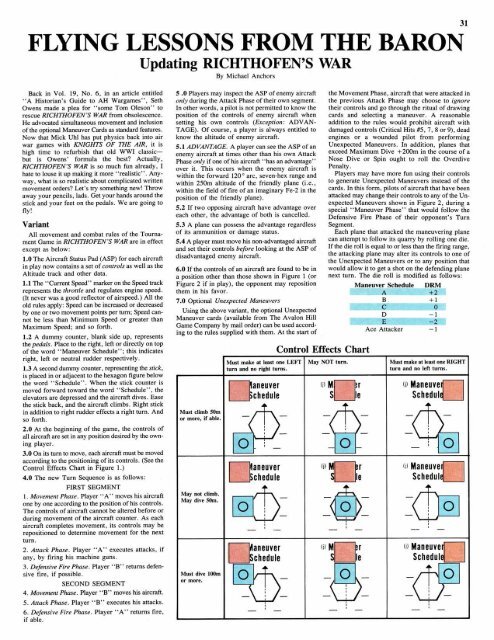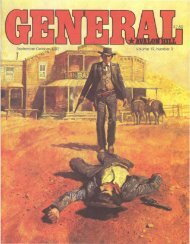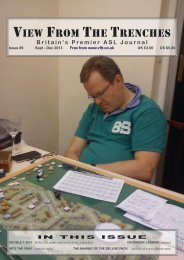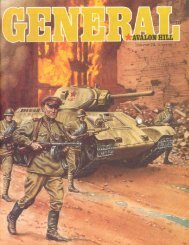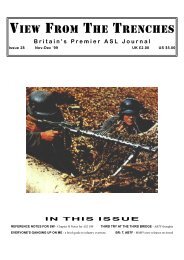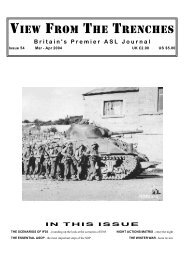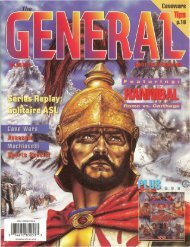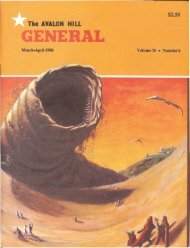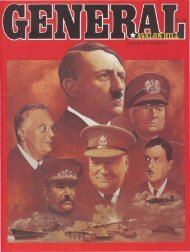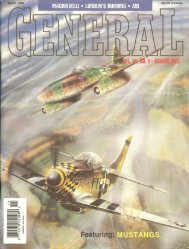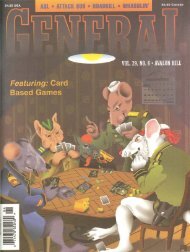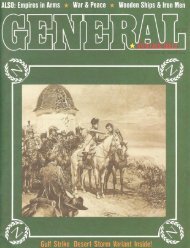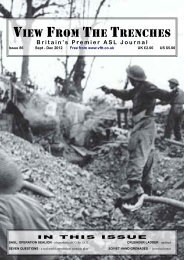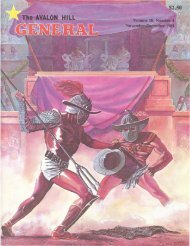18.64MB - View From The Trenches
18.64MB - View From The Trenches
18.64MB - View From The Trenches
- TAGS
- trenches
- www.vftt.co.uk
You also want an ePaper? Increase the reach of your titles
YUMPU automatically turns print PDFs into web optimized ePapers that Google loves.
FLYING LESSONS FROM THE BARON<br />
Updating RICHTHOFEN'S WAR<br />
By Michael Anchors<br />
Back in Vol. 19, No. 6, in an article entitled<br />
"A Historian's Guide to AH Wargames", Seth<br />
Owens made a plea for "some Tom Oleson" to<br />
rescue RICHTHOFEN'S WAR from obsolescence.<br />
He advocated simultaneous movement and inclusion<br />
of the optional Maneuver Cards as standard features.<br />
Now that Mick Uhl has put physics back into air<br />
war games with KNIGHTS OF THE AIR, it is<br />
high time to refurbish that old WWI classic-<br />
but is Owens' formula the best? Actually,<br />
RICHTHOFEN'S WAR is so much fun already, I<br />
hate to louse it up making it more "realistic". Any-<br />
way, what is so realistic about complicated written<br />
movement orders? Let's try something new! Throw<br />
away your pencils, lads. Get your hands around the<br />
stick and your feet on the pedals. We are going to<br />
fly!<br />
5 .O Players may inspect the ASP of enemy aircraft<br />
only during the Attack Phase of their own segment.<br />
In other words, a pilot is not permitted to know the<br />
position of the controls of enemy aircraft when<br />
setting his own controls (Exception: ADVAN-<br />
TAGE). Of course, a player is always entitled to<br />
know the altitude of enemy aircraft.<br />
5.1 ADVANTAGE. A player can see the ASP of an<br />
enemy aircraft at times other than his own Attack<br />
Phase only if one of his aircraft "has an advantage"<br />
over it. This occurs when the enemy aircraft is<br />
within the forward 120" arc, seven-hex range and<br />
within 250m altitude of the friendly plane (i.e.,<br />
within the field of fire of an imaginary Fe-2 in the<br />
position of the friendly plane).<br />
5.2 If two opposing aircraft have advantage over<br />
each other, the advantage of both is cancelled.<br />
Variant 5.3 A plane can possess the advantage regardless<br />
of its ammunition or damage status.<br />
All movement and combat rules of the Tourna-<br />
ment Game in RICHTHOFEN'S WAR are in effect<br />
except as below:<br />
1.0 <strong>The</strong> Aircraft Status Pad (ASP) for each aircraft<br />
in play now contains a set of controls as well as the<br />
Altitude track and other data.<br />
1.1 <strong>The</strong> "Current Speed" marker on the Speed track<br />
represents the throttle and regulates engine speed.<br />
(It never was a good reflector of airspeed.) All the<br />
old rules apply: Speed can be increased or decreased<br />
by one or two movement points per turn; Speed cannot<br />
be less than Minimum Speed or greater than<br />
Maximum Speed; and so forth.<br />
1.2 A dummy counter, blank side up, represents<br />
thepedals. Place to the right, left or directly on top<br />
of the word "Maneuver Schedule"; this indicates<br />
right, left or neutral rudder respectively.<br />
1.3 A second dummy counter, representing the stick,<br />
is placed in or adjacent to the hexagon figure below<br />
the word "Schedule". When the stick counter is<br />
moved forward toward the word "Schedule", the<br />
elevators are depressed and the aircraft dives. Ease<br />
the stick back, and the aircraft climbs. Right stick<br />
in addition to right rudder effects a right turn. And<br />
so forth.<br />
5.4 A player must move his non-advantaged aircraft<br />
and set their controls before looking at the ASP of<br />
disadvantaged enemy aircraft.<br />
6.0 If the controls of an aircraft are found to be in<br />
a position other than those shown in Figure 1 (or<br />
Figure 2 if in play), the opponent may reposition<br />
them in his favor.<br />
7.0 Optional Unexpected Maneuvers<br />
Using the above variant, the optional Unexpected<br />
Maneuver cards (available from <strong>The</strong> Avalon Hill<br />
Game Company by mail order) can be used accord-<br />
ing to the rules supplied with them. At the start of<br />
Must climb 50m<br />
or more, if able.<br />
Control Effects Chart<br />
the Movement Phase, aircraft that were attacked in<br />
the previous Attack Phase may choose to ignore<br />
their controls and go through the ritual of drawing<br />
cards and selecting a maneuver. A reasonable<br />
addition to the rules would prohibit aircraft with<br />
damaged controls (Critical Hits #5, 7, 8 or 9), dead<br />
engines or a wounded pilot from performing<br />
Unexpected Maneuvers. In addition, planes that<br />
exceed Maximum Dive +200m in the course of a<br />
Nose Dive or Spin ought to roll the Overdive<br />
Penalty.<br />
Players may have more fun using their controls<br />
to generate Unexpected Maneuvers instead of the<br />
cards. In this form, pilots of aircraft that have been<br />
attacked may change their controls to any of the Un-<br />
expected Maneuvers shown in Figure 2, during a<br />
special "Maneuver Phase" that would follow the<br />
Defensive Fire Phase of their opponent's Turn<br />
Segment.<br />
Each plane that attacked the maneuvering plane<br />
can attempt to follow its quarry by rolling one die.<br />
If the die roll is equal to or less than the firing range,<br />
the attacking plane may alter its controls to one of<br />
the Unexpected Maneuvers or to any position that<br />
would allow it to get a shot on the defending plane<br />
next turn. <strong>The</strong> die roll is modified as follows:<br />
Maneuver Schedul-<br />
Must make at least one LEFT May NOT turn. Must make at least one RIGHT<br />
I turn and no right turns. turn and no left turns. I<br />
2.0 At the beginning of the game, the controls of<br />
all aircraft are set in any position desired by the own-<br />
ing player.<br />
3.0 On its turn to move, each aircraft must be moved<br />
according to the positioning of its controls. (See the<br />
Control Effects Chart in Figure 1.) (1) Maneuver<br />
4.0 <strong>The</strong> new Turn Sequence is as follows:<br />
FIRST SEGMENT<br />
1. Movement Phase. Player "A" moves his aircraft<br />
one by one according to the position of his controls.<br />
<strong>The</strong> controls of aircraft cannot be altered before or<br />
during movement of the aircraft counter. As each<br />
aircraft completes movement, its controls may be<br />
repositioned to determine movement for the next<br />
turn.<br />
2. Attack Phase. Player "A" executes attacks, if<br />
any, by firing his machine guns.<br />
3. Defensive Fire Phase. Player "B" returns defen-<br />
sive fire, if possible.<br />
SECOND SEGMENT<br />
4. Movement Phase. Player "B" moves his aircraft.<br />
5. Attack Phase. Player "B" executes his attacks.<br />
6. Defensive Fire Phase. Player "A" returns fire,<br />
if able.<br />
May not climb.<br />
May dive 50m.<br />
Must dive lOOm<br />
or more.<br />
1 Schedule


